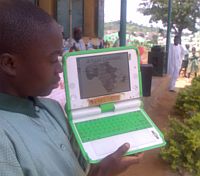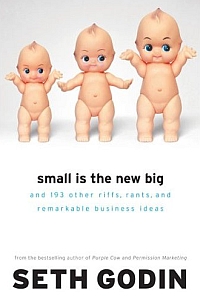I am Carolyn Turbyfill. I believe the OLPC project is one of truly good intentions. It has also become a disruptive technology in a wonderful way.
Now there are two issues floating around the One Laptop Per Child community that have legitimately engendered debate.
- What is the proper product for the OLPC target customer?
- What distribution channel is the best way to get laptops to the target customer?
I'll make two points about product distribution based on my high-tech startup experience: You can compare National versus Local sales to Departmental versus Enterprise sales.
- The first Enterprise sale takes selling to multiple levels of an organization, takes at least 9 months, and needs to translate into purchases in the millions to recoup the cost of customer acquisition. You are selling to multiple departments at a signature authority that exceeds that of any manager whose department will actually use your department, so there will be a CXO signoff required (CIO, CFO, CEO).
Furthermore, all the big guys are in there competing with you, and if you are a little guy, never never assume that your product will win because it is the best thing technologically, that you will win on price, or purity of essence.
- Departmental sales can be achieved with the signature of one person (a director or less, and will be in the tens of thousands, and not millions of dollars.) You can be too small at first to attract big company antibodies (well funded sales teams, lobbyists, metoo buzzword compliant products rushed to market to fill a newly created market category).
I can recommend four sources more authoritative than my personal experience of eight years in developing countries:
- "Small Is Beautiful: Economics as if People Mattered" Schumacher recommends smaller projects implemented locally with renewable resources as opposed to large bloated environmentally destructive projects that renders the "alleged" beneficiaries powerless to influence or be part of the change.
- "The Ugly American" A timeless classic, as true today as when it was written in 1958. Talks about small projects that would make a difference versus politically motivated, ethnocentrically conceived pork barrel projects imposed from afar with no benefit to the impoverished people for whom the aid is ostensibly intended.
- "The Tragedy of American Diplomacy" Williams was one of the first revisionists - who wrote history from government documentation as opposed to the official line. A relevant point in this book is that most U.S. foreign aid money actually goes to technology licenses back to U.S. companies.
- "One Straw Revolution" by Masanobu Fukouka. A major pioneer of sustainable agriculture who likes to say of himself that he has no knowledge, but his books illustrate that he at least has wisdom




This reminds me of Kerala region of India, where in the late 1980' a regional project achieved a near 100% literacy rate. This brought economic growth and reduced the population growth. So, you are right regional education project are easier to set-up, but it is not said, that they spread on a larger scale. The project in Kerala remained the only one of its kind in India.
OLPC wants to aim higher, and in doing so risks a bigger fall, but also a bigger pay off if it succeeds.
I recommend that a person or organization negotiate strongly with Negroponte to sell at the $200 price but buy 100 in bulk. Those computers would then be resold piecemeal at about $220 (with shipping & handling) to schools, programmers, and individuals to test out. I have the $20,000 but am unsure that I could sell 100. Plus there is no way Negroponte would sell at that cost for such a small order (you need to order 100,000).
OLPC unfortunately must sell this way. It would be way to easy for "small" orders to start getting turned around on ebay for $600 each or more.
Remember the sales strategy is about making sure the laptops get into the hands of the intended users... With that said, this kind of revolution must grow from the ground up. Perhaps schools in the first world will start selling them to families...?
If there is a market for $600 XOs then a person could buy 100 at $300/each and turn a nice profit. That's possible today. If it's true that they'll be impossible to buy next year then OLPC is saying "if you want one buy it on ebay." If OLPC made them available for as much as $250 (with a warranty) they could use the extra money to fund their mission. Schools in the first world selling them to their students is a good idea, the question is where do the schools get them and how much do they pay for them?
Hello Carolyn
I think you're quite right. In fact, I think it might be helpful if we were to think of computing, and book-reading, as being two quite separate things.
It's quite true that you can read a book on a computer, but that doesn't necessarily mean that we have to be able to compute using a book-reading device.
And this is especially true if it turns out that we could build and distribute such a 'book-reader' an awful lot more cheaply than a laptop computer. We could then, almost, have the best of both worlds: we could teach the world to read for very little money indeed, and then help those who wanted to go farther up the knowledge-ladder to use a computer, if that's what they need.
Cheers and love,
Martin Woodhouse
Hi Carolyn,
I like your train of thought and I think it has been echoed by some in OLPC. For example, David Cavallo has written about the challenges of making change in education at the mass level. http://www.laptop.org/Models_of_Growth.pdf
As I see it, his concern is that changes dictated from above and implemented everywhere will become institutionalized and co-opted.
I think that's more relevant than the challenge of "making the sale". Hundreds of thousands of laptops are moving out to schools already. The challenge now is how to best build and support the SW and HW to make it useful. Its especially important for students and teachers to take the XO and make it something useful for them.
Its similar to the requirements gathering process of commercial software. The big difference is that it needs to be a collaboration where developers and XO users learn together what is important and what can be built.
So I think you are on the right path with this question: "What is the proper product for the OLPC target customer?"
The XO users, the open source community and the XO developers need to work together to find the right answers to that. Its a process that will take time and a lot of interaction. The result could be a really useful and utilized product that succeeds in its first deployments.
Thanks,
Greg Smith
i think in Kerala has a immense potential for OLPC. A volunteer programme with association with the Technopark would/should work